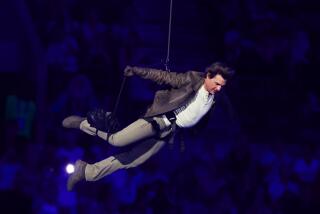Stanley Donen brought wit, style, heartache and joy to the movies
What does pure joy look like on screen? Stanley Donen gave us no shortage of possible answers. Fred Astaire suavely defying the laws of gravity in “Royal Wedding” is one. The marvelously inventive barn-dancing number in “Seven Brides for Seven Brothers” is another. By now it feels almost unnecessary to mention Gene Kelly in “Singin’ in the Rain,” splashing up a storm in a sequence of such iconic power it could justify the invention of motion pictures all by its glorious lonesome.
There are less obvious possibilities too. There’s Kelly dangling his sailor buddy from the top of the Empire State Building in “On the Town,” and also Kelly and his ex-G.I. buddies dancing with garbage-can lids strapped to their feet in “It’s Always Fair Weather.” There’s Audrey Hepburn adrift in the Paris of “Funny Face” and “Charade,” or bickering with Albert Finney as they tear their way through the countryside in “Two for the Road.” Can a marital squabble be a joyful experience? In company like this, it can.
The world feels less joyful without Donen, the director and choreographer who, until his death Thursday at age 94, was one of Hollywood’s last remaining links to its storied golden age. A kid from Columbia, S.C., who fell in love with the movies at an early age and quickly sought refuge in them, he began as a stage dancer before becoming a choreographer and eventually a director. His filmography is one of boundless pleasures, of ebullient miracles casually and generously given, graced by a sophisticated lightness of touch and a delicate wit that seem to have all but vanished from American movies.
Stanley Donen, co-director of ‘Singin’ in the Rain,’ dies at 94 »
I remember seeing those qualities on full display in the charming “Cheek to Cheek” soft shoe routine that a 73-year-old Donen performed at the 1998 Oscars ceremony, where he received an honorary Academy Award. It may have been a lovelier moment than the Academy of Motion Picture Arts & Sciences deserved, given that it had never nominated him for a competitive directing prize. But then, as Donen himself noted in his acceptance speech, directing wasn’t so hard.
“I’m gonna let you in on the secret of being a good director,” he said. “For the script, you get Larry Gelbart or Peter Stone, or Huyck and Katz or Frederick Raphael, like that. If it’s a musical, for the songs, you get George and Ira Gershwin, or Arthur Freed and Herb Brown, or Leonard Bernstein and Comden and Green, or Alan Lerner and Fritz Loewe, like that. And then you cast Cary Grant or Audrey Hepburn, Fred Astaire, Gene Kelly, Sophia Loren, Richard Burton, Rex Harrison, Gregory Peck, Elizabeth Taylor, Burt Reynolds, Gene Hackman or Frank Sinatra! Like that!
“And when filming starts,” he said, “you show up and you stay the hell out of the way. But you’ve gotta show up. You’ve gotta show up, otherwise you can’t take the credit and get one of these fellas.”
He was being self-effacing, of course. But there may have been a deeper layer of truth to his words. Donen was a master at conceiving and using screen space, and the most sublime passages in his movies are marked by a tremendous sense of fluidity and visual freedom: It’s not just that the camera is always in the right place, but that the very world seems to have opened up around it. For Donen, perhaps staying the hell out of the way meant clearing a path for the material, allowing it to find its truest shape and most beautiful expression. It wasn’t a passive act, but one that demanded enormous creativity and intense discipline.
He learned as he went. For Charles Vidor’s “Cover Girl” (1944), it was Donen, an uncredited assistant choreographer, who helped conceive the elaborate visual trickery that allowed Gene Kelly to dance with his ghostly reflection in the “Alter Ego” number. Donen and Kelly launched their famous (and famously combative) collaboration as co-directors with the glorious “On the Town” (1949), which remains a notable early example of a feature-length musical shot extensively on location. Without its New York backdrops, the picture would surely have had little of the same integrity, or the same sense of wide-open possibility.
To watch Donen’s movies is to see a genius of craft evolving alongside his medium, tinkering with the form and pushing against its assumed boundaries. Finding ingenious solutions to daunting technical challenges undoubtedly brought about some of his best-remembered sequences, like Astaire’s “You’re All the World to Me” number in “Royal Wedding,” or the delectably naughty split-screen that allows Cary Grant and Ingrid Bergman to almost-but-not-quite share a bed in the romantic drama “Indiscreet.” (Donen’s glee at pulling a fast one on the censors with that one is palpable — and impossible not to share.)
That may partly explain why “Singin’ in the Rain,” with its unassailable reputation as the greatest of Hollywood’s musicals, remains the director’s most enduring and fully realized work. The story itself is a paean to collective problem solving: Hilariously spoofing the medium’s difficult shift from silents to talkies, the movie follows an inventive, high-spirited group of filmmakers as they find a brilliant way to repurpose old material. That plot summary, of course, also describes the improbably grand achievement of Donen, Kelly, Debbie Reynolds, Donald O’Connor and screenwriters Betty Comden and Adolph Green themselves, who took an old MGM song list (furnished by producer Arthur Freed, the mastermind) and spun it into a wondrously coherent fever dream of the movies.
A picture like “Singin’ in the Rain,” boasting so many disparate yet beautifully harmonized contributions, might seem to gently refute the auteur theory, as did a lot of productions that came off the MGM musical assembly line. Donen’s Oscar acceptance speech may have been his own statement of anti-auteurist principles, his reminder that his own style invariably melded with those of his performers, choreographers and other key collaborators.
But then, how to account for the unmistakable Donen touch — the teasing, delicate hand with romance, the exquisite melding of humor and melancholy, the insistence on visual rapture — that can clearly be seen and even more clearly felt? His work beyond MGM, from the sparkling Hitchcockian bauble “Charade” to the goofy Old Hollywood parody “Movie Movie,” shows its own restlessly creative streak, an impish gift for appropriating and reconstituting classic forms.
And also responding to new ones. “Two for the Road,” his 1967 triumph with Hepburn and Finney (the latter of whom died earlier this month), was the director’s tribute to the creative energy and jumpy vitality of the French New Wave. An impossibly brittle and tender portrait of the dissolution of a marriage, the movie is Donen in gorgeous fragments, zigging and zagging its way through time and into your heart. It has all the surface beauty of his earlier movies, all the color, sophistication and glamour that had become his signature, but this time with a piercing undertow of uncertainty and regret.
It’s a reminder that Stanley Donen didn’t just show up; he showed us how it could be done — like that.
From the archives: Stanley Donen made film sing but never got an Oscar nomination »
More to Read
Only good movies
Get the Indie Focus newsletter, Mark Olsen's weekly guide to the world of cinema.
You may occasionally receive promotional content from the Los Angeles Times.









